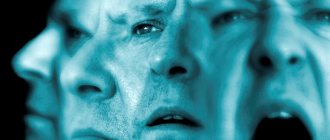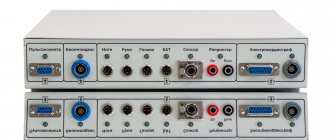Schizophrenia can be combined with other mental disorders. In some cases, it is complicated by addiction to psychoactive substances and alcoholism. The problem of combining schizophrenia with affective and neurotic disorders, epilepsy and a number of other diseases of the nervous system seems difficult.
Mental disorders, comorbid schizophrenia
- Depressive spectrum disorders
- Substance abuse
- Panic attacks
- Social phobia
- Post-traumatic stress disorder
- Obsessive-compulsive disorder
In recent years, one can find evidence in the literature that the risk of schizophrenia increases slightly in people with epilepsy, those who have suffered traumatic brain injury, and those with a low IQ. However, many psychiatrists question the results of such studies (David A., Prince M., 2005).
Mental disorders accompanying schizophrenia, as a rule, complicate the formation of compliance with the patient, reduce the effectiveness of treatment, lead to frequent relapses of the disease, long periods of hospitalization and often cause increased severity of side effects of drug therapy.
Alcoholism
Alcoholism, as a concomitant disease of schizophrenia, has been known for a long time. Back in 1909, K. Graeter described “forms of schizophrenia with an alcoholic onset.” Clinical aspects and features of treatment of patients with schizophrenia who suffer from alcoholism, including alcoholic psychoses arising from “schizophrenia,” are reflected in the works of S.G. Zhislina (1935, 1940), A.A. Perelman (1944), I.I. Lukomsky (1960, 1962), A.G. Goffman (1960), V.M. Banshchikova (1963), etc. In our country, the monograph by S.G. is considered a classic. Zhislina “Essays on Clinical Psychiatry” (1965), in which special attention is paid to the clinical features of the course of schizophrenia if it is complicated by alcoholism.
In the mid-twentieth century, the problem of the influence of alcohol on the clinical symptoms of schizophrenia was especially hotly debated in the literature. Some authors believed that under the influence of alcohol intoxication, mild manifestations of schizophrenia noticeably intensify, others held the opposite point of view, believing that intoxication psychoses neutralize the symptoms of schizophrenia. So, in particular, M. Goldenberg (1941) noted that in the event of intoxication delirium, the latter seems to displace the symptoms of schizophrenia.
According to I.V. Shlemin (2006), in 12.1% of cases in patients with schizophrenia who abuse alcohol, a combined hereditary burden of these two diseases is detected.
Schizophrenia complicated by alcoholism:
- Atypical nature of the course of alcoholism;
- Relatively late formation of alcoholic personality degradation;
- Weak severity of hangover syndrome, aversion and affective disorders;
- Constant pattern of drunkenness;
- Erasure of negative symptoms;
- Negative attitude towards drug therapy;
- Rapid loss of ability to work;
- Antisocial lifestyle, illegal violations.
The development of schizophrenia in approximately 50% of cases precedes the formation of alcoholism, and the latter has a relatively weak effect on the stereotype of the course of the former. Typically, the combination of schizophrenia with alcoholism develops in the case of its simple form, less often paranoid.
With combined forms, the clinical picture of alcoholism is often atypical. Here, individual syndromes of alcoholism may be unclearly represented, the sequence of their formation is disrupted, and there is a weak expression of affective and psychopathic disorders. On the other hand, attention is drawn to the uniqueness of negative symptoms and the sharpening of some signs of the productive spectrum of symptoms. Paranoid syndromes occur relatively rarely when schizophrenia is combined with alcoholism.
Alcoholic hallucinosis, according to modern views, should be distinguished from schizophrenia, both in its pathogenesis and in the clinical picture of the disease. Here, in the case of long-term abstinence from drinking alcohol and adequate treatment, the disappearance of auditory hallucinations is possible (Greenberg D., Lee J., 2001).
Alcoholic delirium in schizophrenia complicated by alcoholism is a rare phenomenon, but it has some features that distinguish it from classic alcoholic delirium. In the clinical picture of delirium, the productive symptoms of schizophrenia are exacerbated. In the case of the development of delirium in schizophrenia, alcoholic euphoria and alcoholic humor are not observed, fear is less noticeable. In patients with a simple form of schizophrenia who abuse alcohol, clear changes in behavior are noted; after an episode of delirium tremens, they retain residual, rudimentarily expressed delusional ideas for a long time, to a certain extent associated with hallucinatory themes (Korolenko Ts.P., 1969).
Patients with schizophrenia who suffer from chronic alcoholism are characterized by daily or constant drunkenness without pronounced manifestations of hangover syndrome (Goffman A.G., 2006); less often, the form of drunkenness is intermittent.
Patients with schizophrenia and alcoholism most often have a negative attitude towards pharmacotherapy and avoid treatment. Most researchers believe that patients with schizophrenia who suffer from alcoholism should not be treated with benzodiazepine tranquilizers.
When schizophrenia is combined with alcoholism, the ability to work is lost relatively quickly; no more than 30% of such patients work in their specialty, about 50% have a disability.
Illegal violations are committed here more than four times more often than in patients with schizophrenia (Goffman A.G., 2006).
According to A.V. Grazhensky (2006), when schizophrenia is combined with alcoholism, due to the refusal of drug therapy, it is advisable to use long-acting forms of antipsychotics; among drugs that cause incompatibility with alcohol, it is preferable to use cyanamide (Colme).
Neurosis-like schizophrenia: main differences from neurosis
One of the forms of schizophrenia is called sluggish, or in other words, schizotypal disorder, in which a neurosis-like form is distinguished. Unlike classical schizophrenia, which is accompanied by delusions, hallucinations, and personality disintegration, it has symptoms of neurosis, so it is sometimes difficult to distinguish them. With appropriate psychocorrection and medication, remission can be achieved for many years.
Despite the similarity of manifestations, neurosis-like schizophrenia is still different from neurosis. In this situation, it is important for the psychiatrist to establish the correct diagnosis, because under unfavorable circumstances, sluggish schizophrenia can develop into serious mental pathologies - this is its main difference from neurosis.
How to distinguish sluggish schizophrenia from neurosis? These are the symptoms of schizotypal disorder that a doctor pays attention to when making a diagnosis.
- The presence of strange, illogical, and obsessive phobias, for example, that teeth will fall into the gums or the fear of counting to 10, since after this death will occur.
- Hypochondriacal manifestations - the patient suspects that he has terrible, incurable diseases that are only a figment of his imagination.
- Dissatisfaction with some part of one’s body, which seems to the patient to be too ugly or hypertrophied, but in fact is completely normal (for example, the nose or ears).
- Obsessive states that require the repetition of certain actions: for example, going to bed strictly in one position, constantly washing your hands, checking every half hour whether the kettle is turned off, etc.
- The emergence of obsessive ideas that the patient constantly thinks about.
All of the listed symptoms are not characteristic of neurotics, with the exception of some obsessive states. But if they realize the abnormality of their behavior and seek to see a doctor, then with neurosis-like schizophrenia the person does not realize the inadequacy and meaninglessness of their actions.
Substance abuse
In patients with schizophrenia, substance abuse is relatively common as a mental disorder concomitant with schizophrenia . According to S. Andreassen et.al. (1987), “although psychopathological conditions predispose to the abuse of various substances, this abuse also predisposes to psychopathological conditions.” If substance abuse precedes the onset of schizophrenia, it accelerates the time of its onset.
Almost 50% (in the literature this percentage varies significantly - 15-70%) of patients with schizophrenia, most often men, demonstrate dependence on psychoactive substances. At the same time, neurotic (anxiety disorders, phobias), personality and affective disorders are more often combined with alcohol abuse than schizophrenia.
Main causes of substance abuse in schizophrenia
- Use of psychoactive substances for the purpose of self-medication: relief of depressive spectrum disorders, negative symptoms, side effects of antipsychotic therapy;
- Inadequate therapy with drugs that are dangerous in terms of the formation of addiction (benzodiazepines, anticholinergics, etc.);
- Negative suggestibility, imitation of other people;
- Conformism;
- Facilitated access to psychoactive substances.
According to K. Muesser et al., (1990), in the group of patients with schizophrenia, schizoaffective disorders and schizophrenia-like psychoses, 47% drink alcohol, 42% use cannabis, 25% use stimulants, 18% use hallucinogens, 7% use sedatives, 4% - “drugs as such.”
Substance abuse and schizophrenia
- Increased severity of positive symptoms;
- Frequent relapses of schizophrenia;
- Frequent hospitalizations;
- The need for long-term treatment in a special hospital;
- Financial difficulties;
- Viral infections caused by infection through parenteral administration of psychoactive substances;
- Criminal behavior.
It has been noted that patients with schizophrenia are more inclined to take dopaminergic drugs, which partially reduce negative symptoms, while provoking a number of productive symptoms (Steinberg J., 2001). Cocaine and amphetamine, as typical dopamine agonists, are characterized by exacerbation of symptoms of schizophrenia.
Substance abuse usually begins in the context of poor compliance and inappropriate medication treatment. In the case of a combination of schizophrenia with dependence on psychoactive substances, the prognosis is usually unfavorable, regardless of the use of certain antipsychotics.
In second place after alcoholism in patients with schizophrenia is cannabis abuse. According to various authors, the risk of schizophrenia in case of cannabis abuse is on average 6-7% of all cases of relatively regular use of this substance.
Multiple substance abuse is common in schizophrenia. Due to the above, in patients with schizophrenia it is necessary to carefully collect a drug history and, during the initial examination, check for the presence of psychoactive substances in the body by conducting toxicological screening of blood serum and urine. In terms of differential diagnosis, it should be borne in mind that drug addicts have better social adaptation, interpersonal relationships are easier to build, and sexual activity is increased compared to patients with schizophrenia.
Taking drugs can trigger the manifestation of schizophrenia and contribute to its relapse.
For patients with schizophrenia with comorbid drug addiction, it can be recommended to take fairly strong antipsychotics that simultaneously have a weak anticholinergic effect. In addition, patients with a “dual diagnosis” (schizophrenia and substance dependence) should receive antidepressants in addition to antipsychotics.
According to some data, patients with “dual diagnosis” have an increased risk of developing tardive dyskinesia during treatment with antipsychotics. On the other hand, akinesia caused by taking a neuroleptic and the resulting anergy may contribute to self-medication with psychostimulants. Note that correction of extrapyramidal disorders with the help of anticholinergic drugs can also lead to abuse of the latter. One of the first signs of dependence on drugs of this class should be considered changes in the cardiovascular system: ECG widening of the QRS complex, prolongation of the QT interval and the appearance of tachycardia.
In the presence of poor compliance, which, as we noted above, is often observed in such patients, it is possible to recommend the prescription of long-acting forms of antipsychotics, presumably suppressing the craving for a psychoactive drug. In particular, the use of flupenthixol depot was previously widely practiced in the treatment of schizophrenia combined with alcoholism. Some authors note the effectiveness of amantadine in the treatment of schizophrenia complicated by addiction to cocaine and anticholinergic antiparkinsonian agents (Kosten T., 1989).
It is known that patients with schizophrenia who abuse cannabis respond worse to antipsychotic therapy than patients without drug dependence.
The need for a cautious approach to the relief of intoxication psychosis caused by taking psychoactive substances should be emphasized. The administration of classical antipsychotics can cause epileptiform syndrome in case of overdose of stimulants.
In the process of multimodal-oriented psychotherapy for patients with schizophrenia who use psychoactive substances, it is important to improve compliance, increase motivation for treatment (“motivational interview technique”), and develop a long-term rehabilitation program for such patients, including contract therapy options with the mandatory involvement of family members in therapy sick.
Causes of neuroses
Experts believe that the main factor leading to the formation of a neurotic state is psychotrauma of various kinds. This could be a stressful situation at work, an intimate problem, even a psychological trauma that happened in childhood and manifested itself in adulthood.
In childhood, we are in a position of constant imprinting - this is the name given to fixing certain information in memory and depending on it. Many impressions and experiences experienced by a child leave an imprint on his future life.
However, almost every person finds himself in difficult situations, and few people can boast of an absolutely cloudless childhood. Why doesn’t everyone develop neuroses? The fact is that experiences and stress alone do not lead to the development of neurosis. They should lie on the prepared soil. What matters are personality traits, character, and innate temperament.
Some manifestations suggest a neurotic condition, but only a specialist can make a final diagnosis.
Tobacco smoking
Tobacco smoking as a mental disorder is observed in patients with schizophrenia approximately 2 times more often than in the general population (Kelly C. et al., 1999). Almost 80% of patients suffering from schizophrenia smoke, of which almost 100% are men and 47% are women (Ryzhkova O.V., 1999). According to American researchers, about 90% of people with schizophrenia smoke cigarettes, compared with 20% of the general US adult population.
Most patients with schizophrenia tend to smoke. Alcohol and nicotine accelerate the pharmacokinetics of antipsychotics, which leads to the need to increase the dosage of these drugs to obtain a good treatment result.
A number of studies have shown that administration of bupropion SR to patients with schizophrenia significantly reduces nicotine dependence, reducing the number of cigarettes smoked. If we take into account that this drug reduces the severity of negative and depressive symptoms of schizophrenia and is a prophylactic against weight gain in patients, then we can assume that its use can significantly improve the condition of patients with schizophrenia who are prone to smoking.
Diagnosis of these mental disorders
The differences and characteristic symptoms of these diseases serve as the basis for diagnosis. Neurasthenia does not require hospitalization; treatment is carried out in a free form, by mutual agreement with a psychotherapist. The work uses psychotherapy methods. In each individual case, a specialist can use different approaches, methods and techniques for treatment. After a course of psychocorrection, the patient returns to a full life, having in his arsenal auxiliary techniques and techniques for dealing with stress.
Neurosis and schizophrenia have fundamental differences; the most important thing is awareness and understanding of everything that is happening. In schizoid disorder, there is a loss of reality. The personality and mental functions of a person are destroyed. To make a diagnosis, test conversations are conducted with a psychiatrist, a special assessment is the person’s non-verbal behavior, a number of medical procedures (MRI, EEG, CT), neurological, physiological examination are carried out.
The age of the patient is of great importance; scientists often encounter the first manifestations of schizoid disorders in young people in the late stages of adolescence.
The most important indicator of how to distinguish neurosis from schizophrenia is the characteristic symptoms of these disorders. With neurasthenia, auditory hallucinations are extremely rare; rather, there may be visions in the form of images caused by severe fatigue and insomnia. Neurosthenics may have decreased mental capacity, but they do not have delusional ideas or broken speech.
Foreign scientists argue that timely treatment of schizoid manifestations can significantly improve a person’s quality of life and even in some cases lead to recovery.
Depression
Since the beginning of the twentieth century, it has been generally accepted that an affective disorder such as depression is quite common in schizophrenia. At the same time, the point of view of E. Kraepelin (1896) is known about the existence of a contradiction between “dementia praecox” and “manic depression”, a relative dichotomy suggesting the pathogenetic opposition of these pathological conditions. E. Bleuler (1911), on the contrary, included symptoms of depression, in particular anhedonia, among the main manifestations of schizophrenia. The situation was further complicated by the hypothesis of J. Kasanin (1933) about the existence of “schizoaffective psychoses”, in the clinical picture of which manifestations of schizophrenia and affective psychosis seemed to be mixed, however, we note that the term “schizoaffective disorder” was used to a greater extent when signs of schizophrenia were combined with manic states.
At present, the question of whether depression should be considered an integral part of the process of schizophrenia or whether it is an independent mental disorder, a kind of phenomenon conditionally independent of schizophrenia, remains open. However, according to most authors, depression in schizophrenia still does not have a specific etiology (Burrows G., Norman T., 2001).
Recently, the frequency of depression in schizophrenia is often explained by the general increase in patients with depression in the population (Rendon M. et al., 2000).
In almost 50% of cases, patients with schizophrenia who are in the acute phase of the disease show clear symptoms of depression, which weaken in severity as they recover from psychosis. Depression as a pre-manifest disorder is observed in 40% of patients with schizophrenia, and as a prodromal disorder in 20-60%. In the chronic course of schizophrenia, depression is registered in 25% of patients, in thymopathic remissions - in 20% (Ivanov M.V., 2007).
Frequency of occurrence of depression at various stages of schizophrenia
- Prodromal phase - 40%
- Acute phase - 50%
- Stage of remission - 40%
- Remission - 20%
The prognostic significance of depression in schizophrenia is unclear; on the one hand, pronounced affective disorders in schizophrenia partly indicate a favorable prognosis for its course and partly indicate shallow damage to brain structures; on the other hand, depression in schizophrenia is often accompanied by suicidal thoughts. In addition, it can contribute to the resistant course of the disease, its frequent relapses and prolong the length of hospitalization. There is no doubt that the psychopathological structure of depression plays an important role in predicting the course of schizophrenia.
Depressive disorders that arise as schizophrenia progresses are extremely variable in the structure of clinical manifestations. However, they should be distinguished from the manifestations of the sedative effect of antipsychotics and the negative symptoms of schizophrenia. After all, the symptoms of depression and manifestations of negative symptoms are in many ways similar to each other, and in both cases anhedonia, low mood, anergy, motor retardation, poor speech, poor concentration, and a desire for loneliness and social isolation are noted. In addition, depression may be a consequence of a reaction to positive psychotic symptoms such as delusions and hallucinations, or accompany akathisia and akinesia that have developed while taking antipsychotics. Let us note that akathisia increases the severity of suicidal tendencies and has a peculiar, mildly expressed dysphoric coloration of depressive symptoms.
When making a differential diagnosis, it should be borne in mind that a depressive episode, more than schizophrenia, is characterized by feelings of guilt, low self-esteem, dysfunction of the autonomic nervous system, anorexia and a peculiar sleep disorder.
Modern views on the role of depression in schizophrenia
- Depression is a manifestation of the underlying pathological process characteristic of schizophrenia;
- Depression is a consequence of the cyclical course of schizophrenia, the frequency of its exacerbations;
- Depression is a sign of a relatively favorable course of schizophrenia, the result of a transition of symptoms from the paranoid register to a “softer” affective one;
- Depression aggravates the course of psychosis and delays the formation of the remission phase;
- Depression is comorbid and “cosyndromic” with schizophrenia;
- Postpsychotic depression is a pathological defensive reaction of the individual, a consequence of awareness of mental disorder, social problems and limitations caused by schizophrenia (psychodynamic theory);
- Depression is a cause of suicide in schizophrenia;
- Postpsychotic depression is a biological reaction to psychosis that depletes the body;
- Depression is a consequence of the sedative effect of antipsychotics, hyperprolactinemia and extrapyramidal symptoms;
- Depression is the result of drug-induced pathomorphosis.
In the premorbid period, and especially during the prodrome of schizophrenia, the severity of depression in some cases is comparable to a fairly severe affective disorder.
As the manifestation of schizophrenia intensifies, signs of apathy and dysphoria begin to appear in depression to an increasing extent (Vovin R.Ya., 1995). In general, apathy, psychomotor retardation, a feeling of weakness and helplessness, hypochondriasis, and a kind of mental anesthesia are characteristic of schizophrenia. Perhaps less often, depression in this disease manifests itself as dysphoria.
In almost 60% of cases, in the depressed state of patients with schizophrenia, one can identify a component of a meaningless threat, a feeling of an impending vague catastrophe that does not have a clear plot.
According to S. Siris (1991), antipsychotics cannot provoke the onset of severe depression, since clinical experience shows that as positive psychotic symptoms are relieved, a weakening of the severity of depressive symptoms is also noted. In support of his hypothesis, the author also cites the fact that there is no correlation between the concentration of an antipsychotic in the blood plasma and the severity of depression. Proponents of the opposite point of view point out that depression that develops as a result of taking antipsychotics is the result of the latter’s peculiar influence on the dopamine system (Harrow M. et al., 1994).
Depression in schizophrenia increases the risk of suicide. Between 10 and 15% of people with schizophrenia commit suicide and about 40% attempt suicide. A number of studies have found a correlation between the severity of distress, feelings of hopelessness, understanding of the severity of the emerging mental disorder and readiness for suicide (Kim Y. Et al., 1997; Caroll A. et al., 1999).
The risk of suicide is highest in the first 5-10 years of the disease, the first days of hospitalization (50% of suicides occur in a hospital), after the first discharge from the hospital; 20-40% of patients attempt suicide impulsively, and a feeling of hopelessness, more than symptoms of psychosis, accompanies completed suicide,
The patient’s suicidal readiness is influenced by patients’ inflated expectations and their overestimation of their capabilities (Goffman A.G., Ponizovsky P.A., 2006).
Particularly dangerous in terms of suicide is the so-called post-psychotic depression, which manifests itself within 6 months after the first psychotic episode. This fairly persistent depression is registered in 25-50% of cases, and according to some sources, even in 80% of patients (Ivanov M.V., 2007).
In the clinical picture of postpsychotic depression, attention is drawn to the peculiar “lethargy” of patients; typical complaints are about feelings of melancholy and “lack of emotions.” At the same time, patients lose interest in communication.
Among the causes of postpsychotic depression, attention should be paid to the stigma of the disease, poor relationships in the patient’s family, limited interpersonal connections and difficulties arising in the process of study or work, alcohol or psychoactive substance abuse.
As a rule, postpsychotic depression is protracted and resistant to drug therapy.
As noted above, the treatment of depressive spectrum disorders in schizophrenia is quite a difficult task.
Controlled clinical trials have shown that adding tricyclic antidepressants to antipsychotics has no effect on the severity of depression (Rifkin A., Siris S., 1987). Moreover, in some works at the end of the twentieth century, authors wrote about the ability of antidepressants to cause exacerbation of psychosis and the appearance of severe depression after recovery from it (Levinson D. et al., 1999). Some scientists believe that the prescription of antidepressants can be justified only at a certain stage of antipsychotic therapy: at the time of acute psychosis it is inappropriate, on the contrary, at the stage of postpsychotic depression it is legitimate. In all cases, treatment of depressive states in patients with schizophrenia requires an integrated approach, which includes, in addition to drug therapy, adequate psychotherapeutic assistance.
Mechanisms of the antidepressant effect of atypical antipsychotics
- Positive effect on the serotonergic system
- Reducing the severity of cognitive impairment
- Reducing the severity of craving for alcohol and a number of psychoactive substances
- Absence of pronounced extrapyramidal symptoms
- Positive impact on the psychosocial status of the patient
- Compliance with the patient
According to some authors, a number of modern atypical antipsychotics, for example, risperidone, olanzapine, ziprasidone and, especially, aripiprazole, have an antidepressant effect. At the same time, some researchers talk about the ambiguity of the effect of these drugs on the manifestations of depression, suggesting in this case the possibility of the emergence of different variants of its dynamics: “harmonious”, “unmasked” and “post-attack” depression.
Signs of neurosis
The disease manifests itself in completely different ways, but there are also common symptoms:
- increased sensitivity;
- suspiciousness and anxiety;
- sudden change of mood for an unimportant reason;
- depressed mood;
- difficulties in adapting to changed conditions;
- obsessive states.
Rarely, the following factors can lead to the appearance of neurosis:
- infectious diseases of the brain;
- alcoholism, taking psychotropic substances;
- head injuries;
- chronic fatigue;
- lack of sleep.
Due to neurosis, cardiac activity and breathing may be impaired. Problems arise with the gastrointestinal tract, pain in the spine, chills, sleep disturbances and problems in the intimate sphere (impotence, frigidity). Frequent signs of the disease are chronic fatigue, irritability, sensitivity to external stimuli (sounds, smells), dizziness.
Neurotic disorders
In the literature there are works indicating the likelihood of coexistence of schizophrenia with psychogenic diseases - neurotic disorders and even reactive psychoses (Polishchuk Yu.I., 1986; Karvarsarsky B.D., 1990; Immerman K.L., Dmitriev A.S., 1995). At the same time, there is a point of view according to which, in patients with schizophrenia, due to their emotional decline, psychogenic disorders do not develop. Recently, studies on the pathomorphosis of schizophrenia indicate that patients with schizophrenia are influenced by socio-psychological factors and may have neurotic disorders accompanying schizophrenia (Piven B.N., Sheremetyeva I.I., 2003).
According to N. Argyle (1990), up to 45% of patients with schizophrenia experience panic attacks of varying severity in their lives. Classic panic attacks are recorded in 6-33% of patients. Moreover, symptoms of panic attacks can be observed before, during and after a psychotic episode. According to R. Goodwin et al. (2004), panic attacks are observed in adolescents prone to schizophrenia and occur during its prodromal period.
Social phobia is registered in schizophrenia in 15-36% (Morrison R., Bellak A., 1987), post-traumatic stress syndrome in 14-43% (Craine L. et al., 1988), obsessive-compulsive disorder - in 10-26 % of cases (Cassano G. et al., 1998).
The latter disorder is relatively difficult to differentiate from delusion. As a criterion, attention is usually paid to ego-syntonicity (delusions) and ego-dystonia (obsessive-compulsive disorder) of the patient’s experiences. According to many researchers, the presence of obsessive-compulsive disorder symptoms in the clinical picture of schizophrenia indicates an unfavorable course of schizophrenia.
Return to Contents
Can neurosis turn into schizophrenia?
The opinion that neurosis can develop into schizophrenia is erroneous. These diseases are fundamentally different, and primarily differ in the nature of their origin. They may be united by some external manifestations, for example, the presence of phobias, obsessive states, depression, but there are much more fundamental differences - we wrote about them above.
Symptoms of a neurotic disorder disappear after psychological help, and attacks of schizophrenia have a chronic course. Sometimes it is difficult for a doctor to immediately make a correct diagnosis, and what at first seemed like a neurosis turns out to be a mental disorder. However, this does not mean that he still turns into schizophrenia - it’s just that the symptoms of mental deviation appeared gradually, resembling a neurotic disorder at the initial stage.
Treatment of schizophrenia
Just as the symptom spectrum is wide, so are the treatment methods for schizophrenia. Traditionally, helping a patient involves a combination of medication and psychotherapy
. Drug treatment consists of the drugs themselves and therapy with additives. Among the medications that do not cure schizophrenia, but significantly improve the quality of life, there are those whose action is aimed at correcting dysfunctions of proteins in DNA organization, since one of the biological factors of predisposition to the disease is associated with dysfunctions of proteins.
In symptomatic therapy, the use of neuroleptics (antipsychotics) is aimed at improving the patient’s social adaptation and social integration: by acting on the symptoms of psychosis, they are able to stop its progression. To reduce the risk of relapse, highly effective antipsychotic drugs such as clozapine and others (amisulpride, olanzapine, risperidone) are used. At the moment, the effectiveness and much higher percentage of safety of combination drug therapy have been proven: a combination of antipsychotics with drugs of a different nature (benzodiazepine, normotic anticonvulsants)
.
In each individual case, different methods of therapy are used. Yes, electroconvulsive
therapy is especially effective in cases of severe catatonia.
And insulin comatose
therapy, which ceased to be used in the West in the 50s of the last century, continues to be used in the Russian Federation due to the recognition of its uniqueness by some specialists.
In case of acute manifestations of the disease, observation in a hospital may be required. The decision on inpatient or outpatient treatment is made by a specialist, and forced placement in a hospital in the Russian Federation is regulated by law. Recently, the length of hospital stay has been significantly reduced, other methods of monitoring the development of the disease are being developed: psychological therapy, social therapy, neuropsychological rehabilitation, family therapy, creative types of therapy (art therapy, music therapy)
.
Alternative therapies (for example, Soteria houses or an antipsychiatric approach to the treatment of schizophrenia
) aim primarily at destigmatizing the disease.
For schizophrenia, it is advisable to use psychotherapy, which affects the social spheres of the patient’s life, and also promotes rehabilitation and active adaptation.
The symptoms of schizophrenia are so diverse that almost all spheres of life are involved in it: mental, emotional, physiological and social. Previously, it was believed that this disease was constantly progressing and the prognosis could only speak of partial remission. However, recent research in neurology, neurosurgery and psychiatry disputes this fact. In some cases, we can talk about recovery - complete or almost complete, for a long time and sometimes even without maintenance drug therapy. But the most correct goal of treatment is to restore functioning and alleviate symptoms, which subsequently leads to successful social integration and improved quality of life for both the patient and his environment.
When can a diagnosis of schizophrenia be made for symptoms of psychopathy?
Sluggish schizophrenia is sometimes very similar to classic psychopathy. The hallmark characteristic of a diagnosis of schizophrenia is bizarre, inexplicable or inappropriate behavior that occurs in adulthood or adolescence.
In addition, with sluggish psychopathic schizophrenia, unmotivated anger, leaving home, strange fantasies, sloppiness, pronounced pathological hobbies and increasing rejection of other people may be noted. The patient’s worldview and fantasies are so unusual and absurd that they cannot “take root” even in an asocial company, a religious sect or an occult society.
In psychopathic-like sluggish schizophrenia, metaphorical, pretentious speech, stereotypical, amorphous or excessively detailed thinking is noted. Strange sexual desires, increased aggressiveness and delusional short-term states may appear, which are combined with auditory hallucinations.
Timely diagnosis and treatment can reduce the symptoms of the disease, allowing a person to live an almost normal life. Our clinic employs experienced specialists who will help you overcome the manifestations of the disease that are destroying your life.
You can make an appointment with a psychiatrist by phone
+7











